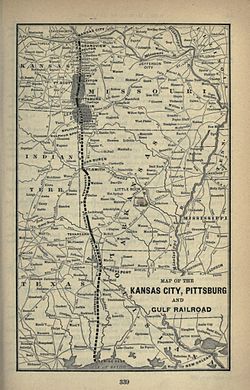Kansas City, Pittsburg and Gulf Railroad
 Projected system map as of 1893; however, Sabine Pass was later discarded as the southern terminus.[1] | |
| Overview | |
|---|---|
| Headquarters | Kansas City, Missouri |
| Locale | Missouri, Kansas, and Texas |
| Dates of operation | 1897–1900 |
| Predecessor | Kansas City Suburban Belt Railway |
| Successor | Kansas City Southern Railway |
| Technical | |
| Track gauge | 4 ft 8+1⁄2 in (1,435 mm) standard gauge |
The Kansas City, Pittsburg and Gulf Railroad was a railway company that began operations in the 1890s and owned a main-line between Kansas City, Missouri, and Port Arthur, Texas. It was led by Arthur Stilwell before being thrown into receivership and eventually being absorbed by the Kansas City Southern Railway in 1900.
Trackage on the KCP&G was complete from Kansas City to Shreveport, Louisiana, as of March 2, 1897. By September 11 of that year, the line ran all the way to Port Arthur, Texas– a town Stilwell essentially created and named after himself.[1] However, the railroad was in financial trouble by 1899.[1] On April 1, 1900, the Kansas City Southern Railway took control of the KCP&G properties after purchasing them at a foreclosure sale in Joplin, Missouri.[1]
The section of the line within the boundaries of Louisiana was chartered as the Kansas City, Shreveport & Gulf Railway Company (KCS&G).[2]
References[edit]
- ^ a b c d "The Completion of the KCP&G – A Centennial History". Lowell G. McManus, The Meridian Speedway. Retrieved August 19, 2020.
- ^ Strouse, L.K. (January 1924). Interstate Commerce Commission Reports: Reports and Decisions of the Interstate Commerce Commission of the United States. Vol. 75. United States. Interstate Commerce Commission. p. 275-292. Retrieved 2021-11-21.
- Predecessors of the Kansas City Southern Railway
- Defunct Arkansas railroads
- Defunct Missouri railroads
- Defunct Kansas railroads
- Railway companies established in 1893
- Railway companies disestablished in 1900
- Defunct Louisiana railroads
- Defunct Oklahoma railroads
- American companies established in 1893
- American companies disestablished in 1900
- United States railway company stubs
